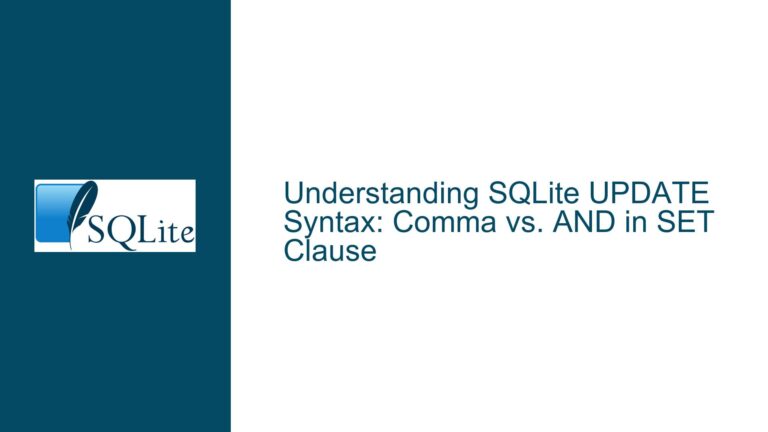Inconsistent COUNT Results with UNION ALL and NATURAL JOIN in SQLite
SQLite COUNT Inconsistency Due to Mixed Affinities in UNION ALL
The core issue revolves around the inconsistent behavior of the COUNT statement when used in conjunction with UNION ALL and NATURAL JOIN in SQLite. Specifically, the problem arises when a view is created using UNION ALL that combines columns with different affinities (e.g., TEXT and NONE). This inconsistency manifests in the form of differing row counts between the SELECT * and SELECT COUNT(*) queries when applied to the same dataset. The root cause lies in SQLite’s handling of column affinities in compound SELECT statements, which can lead to indeterminate results depending on how the query planner interprets the affinities at runtime.
The issue is further complicated by the use of NATURAL JOIN, which implicitly joins tables based on column names and their affinities. When the affinities of the columns involved in the join are indeterminate, the query planner may produce different results for the same query across different SQLite versions or even within the same query execution. This behavior is documented but can be counterintuitive, especially when the SELECT * query returns more rows than the SELECT COUNT(*) query, as seen in this case.
Interplay of Column Affinities and Query Planner Behavior
The inconsistency in the COUNT results is primarily caused by the interplay between column affinities and the SQLite query planner’s behavior. In SQLite, column affinity determines how values are stored and compared. When a view is created using UNION ALL, the affinity of the resulting column is indeterminate if the constituent SELECT statements have different affinities. In the provided example, the v2 view is created using UNION ALL with one SELECT statement returning a TEXT affinity and the other returning a NONE affinity. This mixed affinity setup leads to unpredictable behavior when the view is used in subsequent queries.
The query planner’s transformation of the SELECT * and SELECT COUNT(*) queries further exacerbates the issue. For the SELECT * query, the planner may choose to cast values to TEXT before comparison, resulting in more matches and thus more rows. However, for the SELECT COUNT(*) query, the planner may treat the column as having a BLOB affinity, causing fewer matches and thus a lower row count. This discrepancy is due to the planner’s freedom to choose affinities at different stages of query evaluation, as allowed by SQLite’s documentation.
Another contributing factor is the use of NATURAL JOIN, which relies on column names and their affinities to perform the join. When the affinities are indeterminate, the join condition may yield different results depending on the chosen affinity. This behavior is particularly problematic when the same view is joined to itself, as the join condition may vary based on the planner’s affinity choices. The result is an inconsistent row count between the SELECT * and SELECT COUNT(*) queries, even though they are applied to the same dataset.
Resolving Affinity Ambiguity and Ensuring Consistent COUNT Results
To address the inconsistency in COUNT results, it is essential to resolve the ambiguity in column affinities and ensure that the query planner interprets the affinities consistently. One approach is to explicitly define the affinities of the columns involved in the UNION ALL operation. This can be achieved by using the CAST function to enforce a specific affinity for all constituent SELECT statements. For example, modifying the v2 view definition to cast both SELECT statements to TEXT affinity ensures that the resulting column has a consistent affinity:
CREATE VIEW v2 (v3) AS
SELECT CAST(v1 AS TEXT) FROM v0
UNION ALL
SELECT CAST((v1 IN (10)) AS TEXT) FROM v0;
By enforcing a consistent affinity, the query planner will interpret the column consistently across all queries, eliminating the discrepancy between SELECT * and SELECT COUNT(*). This approach aligns with SQLite’s best practice of avoiding mixed affinities in compound SELECT statements.
Another solution is to avoid using NATURAL JOIN when the affinities of the joined columns are indeterminate. Instead, use an explicit join condition with a consistent affinity. For example, the following query uses an explicit join condition with a TEXT affinity:
SELECT * FROM v2 AS a JOIN v2 AS b ON CAST(a.v3 AS TEXT) = CAST(b.v3 AS TEXT);
This ensures that the join condition is evaluated consistently, regardless of the query planner’s affinity choices. The same approach can be applied to the COUNT query to ensure consistent results:
SELECT COUNT(*) FROM v2 AS a JOIN v2 AS b ON CAST(a.v3 AS TEXT) = CAST(b.v3 AS TEXT);
By explicitly defining the join condition and enforcing a consistent affinity, the query planner will produce consistent results for both SELECT * and SELECT COUNT(*). This approach not only resolves the inconsistency but also makes the query’s behavior more predictable and easier to debug.
In cases where modifying the view definition or join condition is not feasible, an alternative is to use a temporary table to store the results of the view and perform the join on the temporary table. This approach ensures that the affinities of the columns are determined at the time of insertion into the temporary table, eliminating the ambiguity in subsequent queries. For example:
CREATE TEMP TABLE temp_v2 AS SELECT * FROM v2;
SELECT * FROM temp_v2 AS a JOIN temp_v2 AS b ON a.v3 = b.v3;
SELECT COUNT(*) FROM temp_v2 AS a JOIN temp_v2 AS b ON a.v3 = b.v3;
This approach guarantees that the affinities of the columns in the temporary table are consistent, resulting in consistent row counts for both SELECT * and SELECT COUNT(*). However, it introduces additional overhead due to the creation and population of the temporary table, making it less efficient than the previous solutions.
In summary, the inconsistency in COUNT results with UNION ALL and NATURAL JOIN in SQLite is caused by the interplay of mixed column affinities and the query planner’s behavior. Resolving this issue requires enforcing consistent affinities, avoiding NATURAL JOIN with indeterminate affinities, or using temporary tables to ensure consistent results. By following these best practices, developers can ensure that their queries produce consistent and predictable results, even when dealing with complex views and joins.






